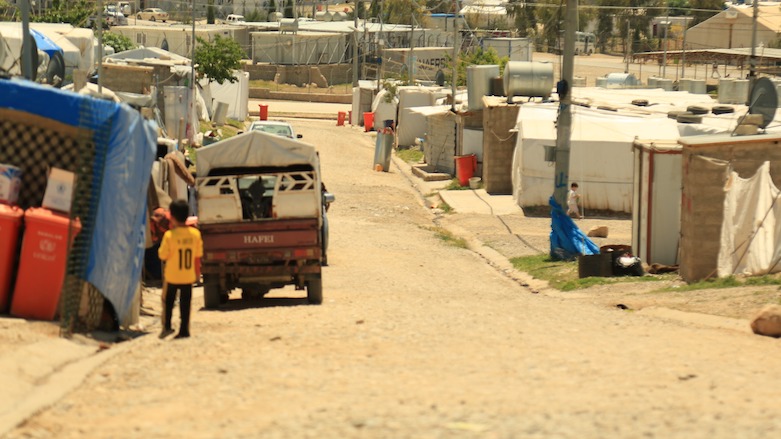Property damage prevents the return of Sinjaris: NRC
"IDPs reported lacking the resources to rebuild their homes, especially with few employment opportunities and delays in government compensation."

ERBIL (Kurdistan 24) – The Norwegian Refugee Council (NRC) in a report on Wednesday said the widespread destruction of civilian houses, new clashes, and social tensions are stopping two-thirds of displaced families from returning to Sinjar.
Why are some Yazidi & Sunni Arabs unable to return to Sinjar while others did?
— Jean-Nicolas Beuze (@jnbeuze) May 18, 2022
• Destroyed houses
• No alternative houses
• Lack of security
• Disputes over property
A @NRC_Norway look at how housing affect options of return.https://t.co/BHPCs8xMiX pic.twitter.com/OQFq7FIlCD
On 3 August 2014, ISIS carried out a genocide against the Yezidi community in Sinjar, displacing thousands to the Kurdistan Region of Iraq.
Nearly five years on from the large-scale military operation by Kurdish forces to drive out the Islamic State group (IS), two-thirds of Sinjar’s population – nearly 200,000 people – remain displaced, the NRC report stated.
An NRC survey of nearly 1,500 internally displaced people and returnees revealed that 64 percent reported their homes heavily damaged, and 32 percent expressed concern that the security situation in Sinjar would prevent them from returning home.
“64 percent of Sunni Arab and Yezidi IDPs (internally displaced persons) reported heavily damaged homes, compared to only 8 percent of returnees. IDPs reported lacking the resources to rebuild their homes, especially with few employment opportunities and delays in government compensation,” the report concluded.
“By contrast, 92 percent of returnees reported that they still had access to the property they held prior to the conflict.”
According to the report, property damage is a “significant impediment to return as IDPs (internally displaced persons) lack the means or resources to rebuild their homes, especially in light of limited livelihood opportunities in displacement and the complexity and delays in compensation.”
“Although 40 percent of respondents reported familiarity with the compensation procedure and 25 percent applied for compensation in the last 12 months, only 0.5 percent have received payment.”
“Many respondents described confusion over how to apply for compensation and in what district, which poses challenges in arranging transportation and collecting civil documentation for those displaced outside of Sinjar.”
Earlier this month, clashes erupted again between the Iraqi army and a local Yezidi armed group in the district, forcing over 10,260 people from their homes, many for the second or third time.
Read More: 1,700 families displaced by recent Sinjar fighting: DMCR
“Families from Sinjar remain in displacement, with thousands still living in camps,” James Munn, the NRC’s country director in Iraq, said in a statement. “We need durable solutions put in place so Iraqi families can once again start living their lives and plan for a safer future.”
“The people of Sinjar want to go back to their homes and rebuild a life after years of tragedy, insecurity, and destruction. But this cannot happen without political and social stability and better access to housing and property rights,” Munn said.
The NRC called on the Iraqi and Kurdish governments to “prioritize the rehabilitation of infrastructure and the restoration of services” in Sinjar.
The NRC also called on international development donors to invest in strengthening access to housing, land, and property rights to support families in finding long-lasting solutions for a future life in Sinjar.
In October 2020, the Government of Iraq and the Kurdistan Regional Government (KRG) signed the Sinjar agreement in an attempt to normalize the situation in Sinjar.
Read More: KRG and Baghdad reach administrative, security agreement on Sinjar
Its purpose is to restore and normalize the situation in the Yezidi-majority region and remove the various armed groups that continue to operate in it. So far, the agreement is not implemented.
“Most of the houses in Sinjar were either destroyed during the war with ISIS or torn apart or abandoned. Most of the houses would have to be built again and many families cannot afford that,” Murad Ismael, the co-founder and president of the Sinjar Academy, told Kurdistan 24.
“This just feeds to the sentiment of not returning as other issues such as security, lack of jobs, and poor government services are already immense enough to persuade people to stay in the camps. There has been no funding to rebuild homes – there has to my knowledge only been one small program by the UNDP (United Nations Development Program) that covered a few hundred homes. Both the government and NGOs can and should help with housing.”
“After 8 years of Genocide, we are realizing that people are not that important, but land and geopolitics around the land are. So I am not surprised that the dominant talk and focus we see is around security because that’s where geopolitical interests, both internally and externally, lie,” he reflected.
However, Pari Ibrahim, the Founder and Executive Director of the Free Yezidi Foundation, told Kurdistan 24 that while “housing and infrastructure are problems, the main problem is that political forces are damaging the inhabitants of Sinjar. It is infuriating.”
“Turkey continues to play its role as a highly destabilizing actor, supporting terror and attacking genocide survivors from the sky,” she added.